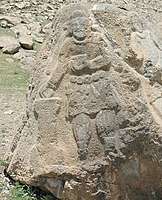Vologases's relief
Vologases's relief is a relief located in the ancient site of Bisotun in Kermanshah Province, Iran, a UNESCO world heritage site. It shows a Parthian king (possibly Vologases III)[1] with a bowl in his left hand. It also has an inscription dedicated to Vologases. This historical heritage was listed in Iranian national heritages on 10 March 2002.[2]
The inscription, written in nine lines on the surface of the altar, uses the Aramaic script to transcribe the Parthian language logographically, and reads:[3]
Vologases, King of Kings, son of (Vo)l(ogases), K(ing of Kings), grandson of P(...)
— Vologases inscription.[3]
Vologases is seen frontally, holding a bowl and sacrificing at an altar, and is flanked by two attendants carved on the sides of the rock.[3] Six kings named Vologases are known to have ruled the Parthian Empire, from 51 to the 220s CE.
 Vologases
Vologases.jpg) Attendant at the proper left of the King
Attendant at the proper left of the King.jpg) Attendant at the proper right of the King
Attendant at the proper right of the King
References
- Olbrycht, Marek (January 2016). "The Sacral Kingship of the Early Arsacids. Fire Cult and Kingly Glory". ResearchGate. Retrieved 14 March 2018. pl:Marek Jan Olbrycht.
- "Files of registration of Iranian national heritages". Archive of Cultural Heritage, Handicrafts and Tourism Organization of Iran.
- Hekster, Olivier; Fowler, Richard (2005). Imaginary Kings: Royal Images in the Ancient Near East, Greece and Rome. Franz Steiner Verlag. pp. 140–142. ISBN 978-3-515-08765-0.